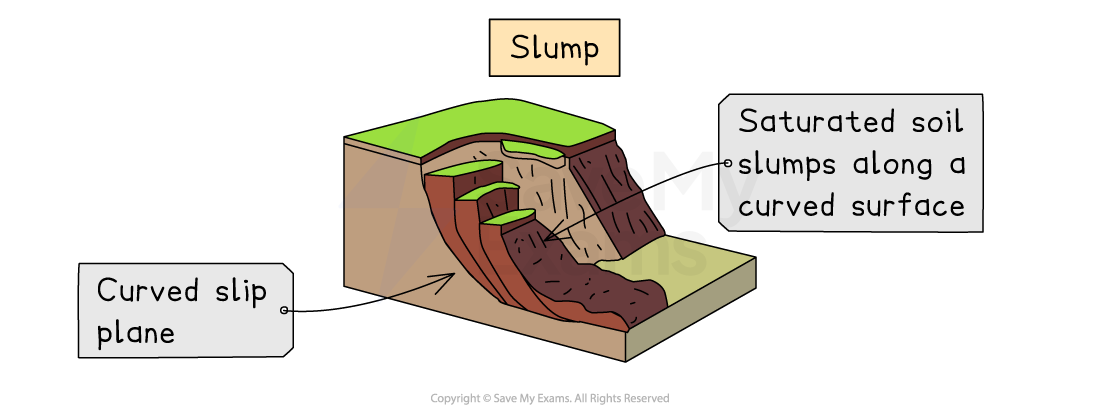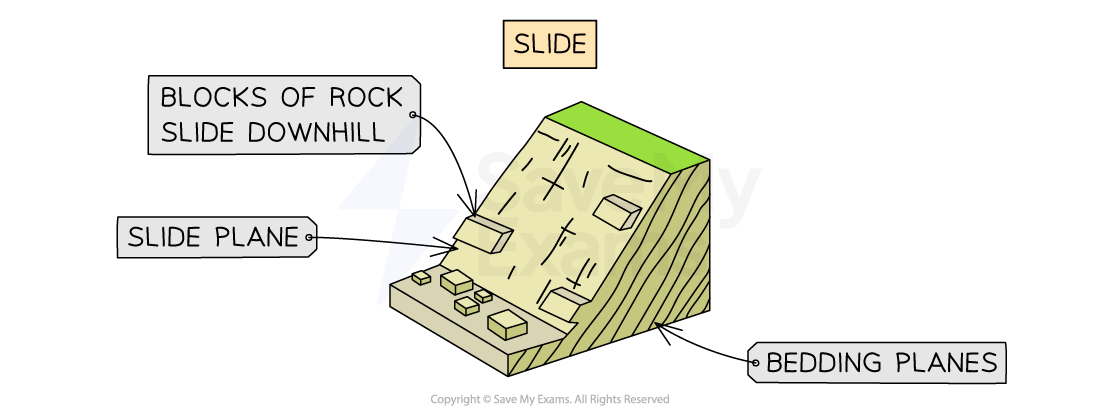Influences on Landscapes (OCR GCSE Geography B): Revision Note
Exam code: J384
Weathering
Geomorphic processes
Geomorphic processes are the methods involved in changing the shape of the landscape
The Earth's surface is continually being made, destroyed and reformed
This is achieved through various methods of erosion, weathering, mass movement, transportation and deposition
Weathering
Weathering is the break-down of rock in its place of origin (in situ)
It is not erosion, as the rock does not move
Types of weathering include:
Types of Weathering
Type of weathering | Process |
|---|---|
Mechanical | Temperature changes cause rocks to break down |
Biological | Rock breakdown due to action of plants and animals |
Chemical | Rock decomposes due to chemical reaction |
Mechanical (physical) weathering
Also called freeze-thaw or frost shattering
This happens in places where night temperatures often reach below freezing
Process of Freeze-thaw Weathering

Biological weathering
Process of Biological Weathering

Nesting birds and small burrowing animals like rabbits can also cause rock to breakdown through biological weathering
Chemical weathering
There are few ways that chemical weathering can occur:
Carbonation - rain is slightly acidic and reacts with limestone, causing them to dissolve
Oxidation - iron minerals in the rock react with the air to cause rust and breakdown the rock
Solution - when salt minerals in the rock are dissolved
Weathering in the UK
The UK's climate is considered to be temperate - there are no extremes of weather
Physical weathering of the UK's landscape is usually slow
However, areas that receive more precipitation and fluctuations in temperature, such as the mountains of Wales and Scotland, see higher rates of chemical weathering and freeze-thaw weathering
Table Showing Climatic Conditions of the UK
Part of the UK | Climate |
|---|---|
North-west | Cool summers, mild winters and high rainfall |
North-east | Cool summers, cold winters and low rainfall |
South-west | Warm summers, mild winters and high rainfall |
South-east | Warm summers, cold winters and low rainfall |
Mass Movement
Mass movement is the downhill movement of material under the influence of gravity
Throughflow and runoff caused by heavy rain can also make cliffs more unstable and increase the likelihood of mass movement
It includes landslides, slumping and rockfalls
The type of movement is influenced by:
The angle of slope (steeper is faster)
Nature of regolith
Amount and type of vegetation
Water
Type and structure of rock
Human activity
Climate
Slide:
A movement of material 'en masse' which remains together until hitting the bottom of a slope
Slump:
Usually found on weaker rock types (i.e. clay), that become saturated and heavy
This is common at the coast and is also known as rotational slip
It involves a large area of land moving down the slope in one piece
Due to the nature of the slip, it leaves behind a curved surface
Types of Mass Movement


Erosion
Erosion is the process by which water breaks-down rock and sediment from rivers and coasts
There are four processes that contribute to erosion:
Hydraulic action:
This is when the sheer force of water compresses air into cracks, that expand and fracture over time
In rivers this is seen along the banks and beds and causes vertical (downward) erosion in the upper part of a river and lateral (sideway) erosion to the banks in the lower course
This action also helps to form the outside bend in a meander in the middle-lower course
On coasts it is when waves smash against the cliff face
Abrasion/corrasion:
This is the process when sediments/rocks/pebbles grind against a river's bank, bed, shoreline or cliffs in a sand-papering effect
Responsible for a river's lateral and vertical erosion
Angular rocks are more effective at 'grinding/rubbing'
Corrosion/solution:
All water is slightly acidic and dissolves soluble rocks, such as limestone or chalk, and carry the dissolved material away, leading to erosion
Attrition:
This is when sediment particles knock against each other and break into smaller, more rounded pieces
In rivers, this action occurs along the river bed and within the water, it does not affect the river bank as this would be abrasion
On coasts, rocks and stones carried by waves hit and knock against each other wearing them down into rounded beach pebbles and sand on beaches
These processes can interact with each other, leading to complex erosion patterns and changes in the shape and form of rivers and coasts over time
Erosion can have significant environmental, economic, and social impacts, such as loss of habitat, damage to infrastructure, and increased risk of flooding and storm damage
Types of erosion

Transportation
Material in rivers and the sea arrives from many sources:
Eroded from cliffs and river banks
Transported by longshore drift along the coastline
Brought inland from offshore by constructive waves
Carried to the coastline by a river
Mass movement
Scree from weathered rocks
Once material is in the water, it is moved in different ways:
Traction
Saltation
Suspension
Solution
Methods of Transportation by Water

Longshore drift
This is the main process of deposition and transportation along the coast
Influenced by the prevailing wind, waves approach the beach at an angle
As the waves break, the swash carries material up the beach at the same angle
As the swash dies away, the backwash carries the material down the beach at right angles (90°)
The process repeats, transporting material along the beach in a zig-zag movement
The Process of Longshore Drift

Worked Example
Describe and explain the process of longshore drift
(4 marks)
Identify the command words and link to the key term
Command words are 'describe and explain' - say what you see and why
Your focus is on 'longshore drift' - what is it?
Answer
Longshore drift is the process where the waves transport material [1], such as sand along the beach in the direction of the prevailing wind [1]. The swash moves material up the beach at an angle [1], as the waves approach in a similar direction to the wind. The material then moves back down the beach at 90° due to gravity [1], this is the backwash. This movement continues along the beach in a zig-zag motion [1] in the direction of the prevailing wind.
Deposition
Deposition is where sediment is dropped and occurs when a river or the sea loses energy
Sediment that is carried by rivers can be deposited at the coast or on the inside of a river bend
Constructive waves deposit material at the shoreline to build the beach and sand dunes
Conditions that encourage deposition in a river include:
A lack of precipitation or over abstraction, will reduce a river's overall discharge
Decreased gradient - the flatter the gradient the less energy there is
Slower flow on the inside of a river bend or where the river is shallower
When the river enters a sea/ocean or lake
Conditions that encourage deposition along the coast include:
Too much material in the water
Too little wind
Waves enter a sheltered area such as a bay and form beaches or mudflats behind spits
Waves enter shallow water
The heaviest material is deposited first, this is known as the load - carried the least distance
The lighter materials; gravel, sand and silt, are known as alluvium - carried at a distance
Dissolved materials are carried out to sea - carried the furthest distance
Worked Example
Name one geomorphic process that erodes landforms.
(1 mark)
Answer
Hydraulic Action [1]
Abrasion / Corrasion [1]
Attrition [1]
Corrosion / Solution [1]
Commentary:
The question asks for one method of erosion, so there would be no extra marks for multiple answers
If weathering had been written, no marks would be awarded - weathering is the break-down of rock in situ, and is not erosion
The same would go for any method of transportation or deposition
Although weathering, transportation and deposition are geomorphic processes and change the shape of the landscape they do not do this through erosion

Unlock more, it's free!
Did this page help you?